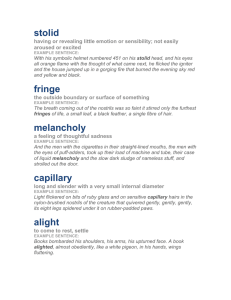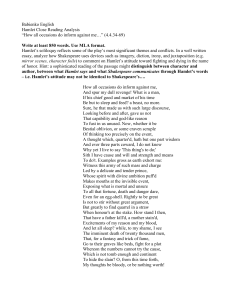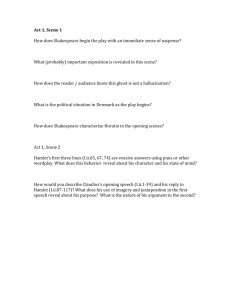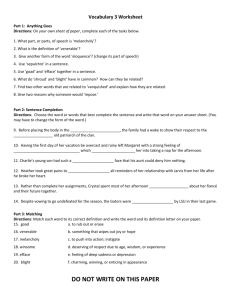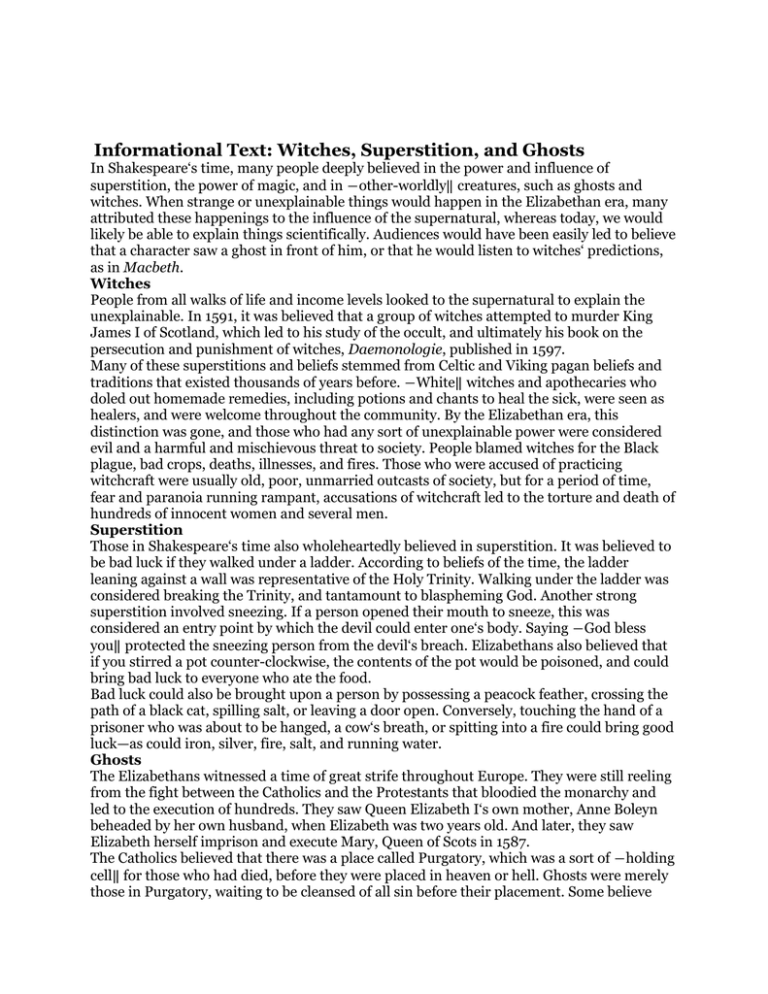
Informational Text: Witches, Superstition, and Ghosts
In Shakespeare‘s time, many people deeply believed in the power and influence of
superstition, the power of magic, and in ―other-worldly‖ creatures, such as ghosts and
witches. When strange or unexplainable things would happen in the Elizabethan era, many
attributed these happenings to the influence of the supernatural, whereas today, we would
likely be able to explain things scientifically. Audiences would have been easily led to believe
that a character saw a ghost in front of him, or that he would listen to witches‘ predictions,
as in Macbeth.
Witches
People from all walks of life and income levels looked to the supernatural to explain the
unexplainable. In 1591, it was believed that a group of witches attempted to murder King
James I of Scotland, which led to his study of the occult, and ultimately his book on the
persecution and punishment of witches, Daemonologie, published in 1597.
Many of these superstitions and beliefs stemmed from Celtic and Viking pagan beliefs and
traditions that existed thousands of years before. ―White‖ witches and apothecaries who
doled out homemade remedies, including potions and chants to heal the sick, were seen as
healers, and were welcome throughout the community. By the Elizabethan era, this
distinction was gone, and those who had any sort of unexplainable power were considered
evil and a harmful and mischievous threat to society. People blamed witches for the Black
plague, bad crops, deaths, illnesses, and fires. Those who were accused of practicing
witchcraft were usually old, poor, unmarried outcasts of society, but for a period of time,
fear and paranoia running rampant, accusations of witchcraft led to the torture and death of
hundreds of innocent women and several men.
Superstition
Those in Shakespeare‘s time also wholeheartedly believed in superstition. It was believed to
be bad luck if they walked under a ladder. According to beliefs of the time, the ladder
leaning against a wall was representative of the Holy Trinity. Walking under the ladder was
considered breaking the Trinity, and tantamount to blaspheming God. Another strong
superstition involved sneezing. If a person opened their mouth to sneeze, this was
considered an entry point by which the devil could enter one‘s body. Saying ―God bless
you‖ protected the sneezing person from the devil‘s breach. Elizabethans also believed that
if you stirred a pot counter-clockwise, the contents of the pot would be poisoned, and could
bring bad luck to everyone who ate the food.
Bad luck could also be brought upon a person by possessing a peacock feather, crossing the
path of a black cat, spilling salt, or leaving a door open. Conversely, touching the hand of a
prisoner who was about to be hanged, a cow‘s breath, or spitting into a fire could bring good
luck—as could iron, silver, fire, salt, and running water.
Ghosts
The Elizabethans witnessed a time of great strife throughout Europe. They were still reeling
from the fight between the Catholics and the Protestants that bloodied the monarchy and
led to the execution of hundreds. They saw Queen Elizabeth I‘s own mother, Anne Boleyn
beheaded by her own husband, when Elizabeth was two years old. And later, they saw
Elizabeth herself imprison and execute Mary, Queen of Scots in 1587.
The Catholics believed that there was a place called Purgatory, which was a sort of ―holding
cell‖ for those who had died, before they were placed in heaven or hell. Ghosts were merely
those in Purgatory, waiting to be cleansed of all sin before their placement. Some believe
that ghosts were put on earth to serve out their time in Purgatory before they were ―moved
The Protestants, however, did not believe in a place called Purgatory, but rather, that souls
were immediately sent to heaven or hell. Two beliefs existed: First, it was believed that the
bodies of the dead were inhabited by spirits and that these spirits came back to cause havoc.
Secondly, it was also believed that ghosts were a figment of the mind—that they were simply
a hallucination or an illusion.
One of the most influential works of literature of the Elizabethan era that stirred the
question of the existence of ghosts was Shakespeare‘s very own Hamlet. While it is not clear
whether Shakespeare himself truly believed in ghosts or spirits, he certainly enjoyed
fascinating and horrifying his audiences with the ghost of Hamlet‘s father in his wildly
popular play.
Comprehension Check: Witches, Superstition, Ghosts
Directions: Based upon the article, answer the following questions on a separate piece of
paper using complete sentences.
1. Why would audiences in Shakespeare’s time listen be easily led by the supernatural as
opposed to today’s audiences?
2. What happened in 1591 which had a great influence on King James I?
3. Explain how witches and superstitions have changed since stemming from the Celtic and
Viking pagan beliefs and traditions. Examine the superstitions and which ones are still
around today.
4. Why had the Elizabethans throughout Europe witnessed a time of great strife?
5. In the Section labeled “Ghosts,” summarize the second paragraph, which starts with “The
Catholic…”
6. How did the Protestants differ from the Catholics?
7. How was Hamlet one of the most influential works of Elizabethan literature?
Madness
INTRODUCTION
Commonly regarded by scholars as one of the consummate portrayers of the human psyche in all of
literature, Shakespeare's finely-drawn characterizations are distinguished by an abiding interest in the
themes of self-delusion, psychological imbalance, and insanity. The accuracy of Shakespeare's insights
into these phenomena has been credited by many as an anticipation of numerous findings of twentiethcentury psychiatry.
Shakespearean scholarship of recent decades has evidenced an increasing historical interest in the
Elizabethan conception of mental illness as a means of shedding new light on such plays as Hamlet,
Macbeth, and King Lear. Several critics have focused in particular on correcting previous misreadings of
key Shakespearean texts by articulating the distinctions between twentieth-century conceptions of the
nature of insanity from those of the Elizabethan period. Carol Thomas Neely, for example, explores the
ways in which madness during the early modern period "began to be secularized, medicalized,
psychologized, and… gendered." Also concerned with a historical perspective are scholars including
Winfred Overholser and Paolo Valesio, who elucidate the elements of Greco-Roman, medieval Christian,
and folkloristic traditions contributing to Renaissance conception of insanity. Some commentators,
including Jack D'Amico, have examined how Shakespeare illustrated connections between madness and
politics through his characterization of the legendary Roman figure Junius Brutus. Similarly, Karin S.
Coddon has read Hamlet in the light of the trial for treason of Robert Devereux Earl of Essex, arguing that
the tragedy dramatizes the Elizabethan notion that political disobedience is a form of madness.
An interest in the relationship between gender and madness has also informed recent Shakespearean
scholarship. Hamlet in particular has been the focus of gender analysis by modern feminist commentators
such as Elaine Showalter, who articulates the historical importance of Ophelia's character to the
"theoretical construction of female insanity." Also examining madness and gender in Shakespeare's plays
are Maurice and Hanna Charney, who associate madness with a form of liberation for Shakespeare's
female characters. Through their analysis of Elizabethan stage conventions, the critics conclude that the
dramatic portrayal of feminine madness "allowed women an emotional intensity and scope not usually
expected in conventional feminine roles."
Source: Shakespearean Criticism, ©1997 Gale Cengage. All Rights Reserved. Full copyright.
Mental illness wasn't regarded as a illness, but as divine retribution for sins, or diabolic possession (devils
or demons). In the 16th and 17th centuries, the world was more superstitious and there was really no
treatment available other than locking the sufferer in a madhouse (look up 'Bedlam'). The only treatment
for the mentally ill (and for children and adults with brain damage or movement disorders/cerebral palsy)
was tying them to the pews in church so that God could heal them.
Medieval physicians used to deal with imbalance of the humours (look up 'humours of the body') as this
was thought to be a cause of madness, and hysteria (literally, a wandering womb thought to be the cause
of madness in women).
Early Modern Attitudes to Madness with Reference to Hamlet and King Lear
In the early modern period, insanity could be attributed to a wide variety of causes. Amongst the supposed triggers of
madness were physical illness, especially fever; an imbalance of ‘humours’ or bodily fluids, thought to give rise to
emotional states such as melancholy or anger; astrological influences; a sinful lack of faith in God’s mercy, resulting
in despair; difficulties in love; and even demonic possession. [1] The inner faculties of human beings were frequently
seen as a microcosm, related to the larger cosmos: Thomas Walkington’s Optike Glasse of Humors (1607),
contained a diagram in which the humours are matched with planets, seasons and natural phenomena: Melancholy is
associated with the astrological signs Cancer, Scorpio and Pisces, with the planet Saturn, the element of Earth, the
North Wind, Winter, and Old Age. [2]
Robert Burton’s Anatomy of Melancholy, first published in 1621, relates that, much like Hamlet, the melancholic is
driven by ‘Feare and Sorrow [...] suspition and discontent’. Melancholics have ‘a canker’d soule macerated with cares
and discontents, tœdiam vitæ, impatience precipitates them into vnspeakable miseries. They cannot indure
companie, light, [they are] vnfit for action’ and ‘their soules [are] tormented’. [3] Love melancholy caused a ‘leane’
appearance, with ‘eyne hollow’ and ‘hew pale’, combined with a ‘solitary disposition’: [4] hence the supposition on the
part of Polonius and Ophelia that this is Hamlet’s trouble. [5] Ophelia’s madness is partly induced by grief, which,
Burton wrote, could make people ‘cry out, howle & roare for very anguish of their soules, and turn them ‘senseless
and stupid’. [6] Burton also felt that unsatisfied sexual desire caused maladies among ‘noble virgins’ and ‘nice
gentlewomen’. They could be ‘violently carried away with this torrent of inward humours’ and be subject to ‘teares,
sighes, groanes, and grievous miseries’. [7] In her madness, Ophelia’s songs reveal preoccupations with both grief
and sexuality, and her drowning may symbolise an inward flood of irreconcilable emotions. [8]
Madness could also be feigned. The Reverend Richard Napier, a seventeenth-century astrologer-physician, records
the 1655 case of Alice Child of Ipsley, who ‘pretending herself to be distracted goes peddling up and down disturbing
the peace’. [9] Men who pretended to be mad in order to beg were called ‘Tom o’ Bedlam’ or ‘Abraham men’ (from the
Abraham ward in Bethlem Hospital or ‘Bedlam’). [10] In King Lear Edgar disguises himself like the ‘Bedlam beggars’
who ‘with roaring voices,/ strike in their numb’d and mortified bare arms/ Pins, wooden pricks, nails, sprigs of
rosemary’ to force charity from the countryfolk. [11] Such men sometimes called themselves ‘Poor Tom’. [12] Edgar too
calls himself ‘poor Tom’ and is called ‘poor mad Tom’. [13] He claims to be vexed by the ‘foul fiend’, [14] and by ‘five
fiends’ associated with sins like lust and murder, [15] reiterating the connection of madness with sin and the Devil.
Hamlet, too, feigns madness, or an ‘antic disposition’. [16] The irony Shakespeare exploits in both Hamlet and Lear is
that, while characters dissembling madness feature in both, so does the idea that madmen lack hypocrisy and speak
the truth. In 1689 Thomas Tryon wrote that ‘Mad People, and innocent Children, do speak, forth whatever ariseth in
their Phantasies’, and ‘appeare naked, having no Covering, Vail, or Figg-leaves before them, to hide themselves in,
and therefore they no longer remain under a Mask or Disguise, but appear even as they are’. [17] Hamlet’s apparent
madness allows him to blurt out truths and shrewd aphorisms along with nonsense, causing Polonius to say, ‘Though
this be madness yet there is method in’t’, and ‘How pregnant sometimes his replies are – a happiness that often
madness hits on, which reason and sanity could not so prosperously be delivered of’. [18] When Lear rants about
worldly hypocrisy whereby ‘robes and furred gowns’ of men of authority hide ‘great vices’, Edgar remarks, ‘O matter
and impertinency mixed,/ Reason in madness’. [19]
Tryon also questioned whether, as Lear’s speech indicates, the madness of the world, rather than of the individual, is
the greatest evil. Tryon argued that sins and vices like ambition, flattery, lust, gluttony and avarice were ‘the main
business and the daily imployment of many’, and accounted them ‘far greater, and more mischievous Phrensies, than
for a man to pull of his Garments, and sit naked, and spend time in weaving of Sraws or Building with Chalk upon the
Walls innumerable Cities, whereof he fancies himself to be Emperor’, [20] an image that vividly recalls Lear in his
madness clinging to the remnants of his kingship. Tryon’s vision of the world as ‘a great Bedlam’ conjures up the
disordered worlds of Hamlet and King Lear, in which a brother may murder a brother to gain a crown, or daughters
feign filial love to gain half a kingdom. As a head of the body politic, [21] Hamlet’s real melancholy and assumed
madness reflect that which is ‘rotten in the state of Denmark’. [22]
Karen Kay
Melancholy was a particularly widespread affliction in Elizabethan England; particularly amongst the
educated classes. It seems to have been reserved more for men than for women (who had more of a
penchant for hysteria), and it brings with it a sense of being trapped in a prison of gloom which is reflected
in Hamlet's world where "Denmark is a prison." (II.ii.247)
Timothy Bright, the most important student of melancholy during the Elizabethan period provides us with
a telling picture of the malady which is amply reflected in Hamlet.
...the fancy ouertaken with gastly fumes of melancholy, and the whole force of the spirit
closed vp in the dungion of melancholy darkness, imagineth all dark, blacke and full of
feare...
- Timothie Bright. Treatise of Melancholie. (Repro of 1586) New York: Columbia Univ.
Press. 1940. p.189.
Several modern writers on Elizabethan society have noted the prevalence of this malady. Here are a few
examples from important authors who have dealt with this topic.
Melancholy was very much in vogue in the England of Elizabeth and the early Stuarts,
especially among the intellectuals and would-be intellectual. Elizabethan and early Stuart
literature, consequently, abounds in references to melancholy and in melancholy
characters.
- Lawrence Babb, The Elizabethan Malady, Michigan State College Press, 1951.p.vii.
The last years of Queen Elizabeth and the reign of James I, towards the end of which
Burton's Anatomy appeared, were marked by the prevalence of a particular kind of
melancholy. All classes were affected by it... It gave the tone to a group of tragedies
produced in the early years of the century and provided a background even for comedy.
- L.C.Knights, Drama and Society in the Age of Jonson, Chatto and Windus,
London.1937. p.31
Robert Burton published the first edition of the Anatomy of Melancholy in 1621, and the
fame of his book has somewhat obscured the fact that the author was not the first but the
latest of the great melancholics of the seventeenth century. Melancholy, indeed, is one of
the commonest strains in English writers... in the generation preceding the Anatomy it
was the prevailing mood with intelligent writers. Few of them escaped it.
- G.B.Harrison, "On Elizabethan Melancholy" in Melancholike Humours (Nicholas
Breton). Scholartis Press, London. 1929. p49.
A briefe of sorrowe
Muse of sadness, neere deaths fashion,
Too neere madnesse, write my passion.
Paines possesse mee, sorrows spill me,
Cares distress me, all would kill mee.
Hopes have faild me, Fortune foild mee,
Feares have quaild me, all have spoild mee.
Woes have worne mee, sighes have soakt mee,
Thoughts have torne mee, all have broke mee.
Beauty strooke me, love hath catcht mee,
Death hath tooke mee, all dispatcht mee.
- Nicholas Breton, Melancholike Humours (1600), Scholartis Press,
London. 1929. p.14,
L.C. Knights associates the fascination with melancholy with two social trends that were particular to late
sixteenth century and early seventeenth century England. These were the prevalence of death through
plague and warfare and the failure of the society to provide occupations for its educated class. In
particular, the lack of opportunities for the educated (generally men) provides one of the common faces of
melancholy, and the afflicted were frequently scholars; much like Hamlet.
The realization of death was one of the most important factors in producing melancholy.
Men of the Middle Ages had also been fascinated by death,...but they had not fallen
victims to the kind of melancholy under discussion. ....On the Continent the sixteenth and
seventeenth centuries were a period of almost continuous warfare, and both abroad and
in England the plague continued to exact its enormous toll of human life.
- L.C.Knights,Drama and Society in the Age of Jonson. Chatto and Windus. London.
1937.pp. 320-321.
Under Elizabeth there had been a considerable increase of educational activity, with a
consequent heightening of men's expectations. Even before the close of the sixteenth
century there were more than a few who could find no place in the existing organization of
the state... There is no need to stress the hardships of university men and the difficulty
that they had in obtaining suitable employment. Scholars and writers were not the only
discontented members of the commonwealth. Those who sought a public career were
just as likely to have their hopes thwarted, or if they achieved success, it was only after
long years of disappointment and delay.
- pp. 324-327.
At the time that Shakespeare was writing Hamlet, the most important work on the subject of melancholy
was Dr. Timothy Bright's Treatise of Melancholy. Two editions of this work came out in 1586, and a third
was to appear in 1612. Bright states that melancholic humors, being cold by nature, settle in the spleen
which causes vapors to rise past the heart to the brain. This process proves to be both disheartening and
the cause of unreasonable behavior.
The perturbations of melancholy are for the most parte, sadde and fearful, and such as
rise of them: as distrust, doubt, diffidence, or dispaire, sometimes furious and sometimes
merry in apparaunce, through a kinde of Sardonian, and false laughter, as the humour is
disposed that procureth these diversities. Those which are sad and pensive, rise of that
melancholick humour, which is the grossest part of the blood, whether it be iuice or
excrement, not passing the naturall temper in heat whereof it partaketh, and is called cold
in comparison onely. This for the most part is setled in the spleane, and with his vapours
anoyeth the harte and passing vp to the brayne, counterfetteth terrible obiectes to the
fantasie, and polluting both the substance, and spirits of the brayne, causeth it without
externall occasion, to forge monstrous fictions, and terrible to the conceite, which the
iudgement taking as they are presented by the disordered instrument, deliuer ouer to the
hart, which hath no iudgement of discretion in it self, but giuing credite to the mistaken
report of the braine, breaketh out into that inordinate passion, against reason.
- Timothy Bright, A Treatise of Melancholie, (1586), Facsimile Text Society, New York,
1940. p.102.
Elizabethan psychology was a direct descendent of the theory of humors that originated with the Ancient
Greeks. The original concept was based on the assumption that the world was composed of four primary
elements (earth, air, fire and water), and that these elements were reflected in four basic fluids that flowed
in various combinations in the human body; blood, phlegm, yellow bile, and black bile. Of these, black bile
determines the disposition toward melancholy, and the word itself "melancholy" comes directly from the
Greek for "black bile."
By Shakespeare's time, a complex structure of medical theory had been superimposed on the concept of
humors, but the basic theory remained very much the same.
When Shakespeare, Burton and other Renaissance writers gave melancholy the complex
meanings and associations it has in their work, they were drawing on a tradition that had
been developing throughout classical antiquity and the Middle Ages, and whose diverse
origins made it an especially fruitful subject for literature.
- Bridget Gellert Lyons, Voices of Melancholy, Barnes and Noble, New York, 1971. p.1.
A person's psychological disposition was the direct result of the proportions of the four basic fluids in the
body.
The body of man has in itself, blood, phlegm, yellow bile, and black bile; these make up
the nature of his body, and through these he feels pain or enjoys health. Now he enjoys
the most perfect health when these elements are duly proportioned to one another in
respect of compounding power and bulk, and when they are perfectly mingled. Pain if felt
when one of these elements is in defect or excess, or is isolated in the body without being
compounded in the body with all the others.
- Hipporcates, The Nature of Man, trans. W.H.S.Jones, Loeb Classical Library, London,
1931, v.IV. pp. 11-13.
Over time, the humors came to be associated with a cosmology that extended the human body far
beyond its original confines. Each of them represented such things as the seasons, organs, planets,
cardinal directions, etc. in addition to psychological attributes. The following two charts, give a sense of
the elements associated with the various humors.
Humor
Element
Season
Attributes
Organ
Sanguine
blood
air
spring
hot and wet
sweet
red
liver
Choleric
yellow bile
fire
summer
hot and dry
bitter
yellow
gall
Melancholic
black bile
earth
autumn
cold and dry
sour
black
spleen
Phlegmatic
phlegm
water
winter
cold and wet
tasteless
white
lungs or
kidneys
Humor
Planets
Functions
Directions
Attitude
Sanguine
Jupiter
nourish fleshy parts and warm the body
south
cheerfulness
simplicity
Choleric
Mars
provoke the expulsion of excrement
east
rashness
anger
Melancholic
Saturn
nourish the bones gristle and sinews
north
sadness
contrariness
deliberation
Phlegmatic
Venus or
the Moon
nourish the brain and kidneys
west
heaviness
foolishness
I am but mad north-northwest: when the wind
is southerly, I know a hawk from a handsaw.
II.ii.388.
Audiences familiar with the humors and the variety of signifiers attached to each of them will find
numerous references to them throughout Hamlet. In the above line, for example, Hamlet uses the
relationship of the humors to the cardinal points of the compass and the winds emanating from them to
make a mockery of this mode of analysis.
In addition to the various planets, directions, seasons, elements, etc., there is also a mythological
heritage attached to each element. The reference to melancholy as a Saturnine humor, for example, goes
beyond the association of the humor to the planet, Saturn. Saturn is the Roman manifestation of the
ancient Kronos; once the ruler of the Titans during their Golden Age. As such, he became the god of
agriculture. Subsequently, however, he was overthrown and castrated by his son Zeus and the
Olympians and imprisoned in a dark place deep in the earth. Kronos is also associated with Chronus, the
god of time, and as such is seen as a representation of old age and death. The cold and dry attributes of
melancholy are also considered representative of the condition of old age.
Such a system of associations provides the basis for a large number of symbolic connections throughout
the play.
Shakespeare scholars have made convincing arguments about the likelihood that Shakespeare was
familiar with Timothy Bright's work, paying particular attention to Hamlet. Whether Shakespeare knew the
actual work is subject to surmise, but it seems quite likely that the understanding of melancholy contained
in Bright's work soon gave way to an underlying theory about the affliction which is represented in Hamlet.
It is natural to conclude that Shakespeare used the Treatise [of Melancholy] in his task of
fitting a ready-made destiny with a convincing character. With this conclusion, the dates,
the popular appeal of the Treatise, the parallel passages, all agree... Thus, in the light of
Bright's Treatise we get the outlines of a Hamlet of Elizabethan psychology. This Hamlet
is not a puppet of dramatic circumstance, pulled now by Kyd's strings, and now by
Shakespeare's, but a character unified by the qualities of the melancholy man, as Bright
presents them.
- Mary Isabelle O'Sullivan, "Hamlet and Dr. Timothy Bright," PMLA v. xl (1926) pp. 678-9.
With regard to causes, Timothy Bright begins with the assumption that melancholy, like all the other
humors, has its first cause in diet.
As all naturall humours rise of nourishment, so melancholie being a part of the bloud,
from thence it springeth also.
- Timothy Bright, A Treatise of Melancholie, 1586, Facsimile Text Society, New York,
1940. p.4.
Nourishment plays a large part in the process of determining the proportions of the humors, and thus the
health and inclinations of the individual. The process of digestion (called concoction ) takes place in three
stages. In the first, the stomach produces a whitish fluid called chyle. It is then carried to the liver (a hot
organ) where further concoction produces the four primary humors. The heaviest of these, melancholy, is
believed to be a sludge which sinks to the bottom and is, therefore, semiexcremental. When the fluids are
transported to the heart for further refinement, the purest blood is transformed into the vital spirits which
animate and warm the entire body. If the flow of vital spirits is restricted, the blood can degenerate into
melancholy. The vital spirits are rarefied into an even subtler vapor in the brain called the animal spirits
(Latin anima ) which flows in the nerves just as the vital spirits flow in the arteries and veins.
Here's a list of foods which, according to Timothy Bright, can occasion melancholic humors.
vegetable
colewarts
beet
cabbage
quince
dates
olives
acorns
sodden wheat
unleavened bread
bag puddings
pan puddings
fritters
pancakes
Banbury cakes
wedding cakes
Meat
muscle parts
plovers
secretions
peacock
kidney
seals
liver
porpoise
heart
eel
blood and blood dishes
ling
pork (except corned with salt)
salt fish
ram mutton
skate
goat
cockles
boar
mussels
venison
periwinkles
water fowl (except goose wings)
thrushes
sparrows
martins
turtles
ringdoves
quail
Needless to say, diet was not thought to be the only cause of melancholy, and, according to common
belief, certain emotional causes sat at the top of the list of suspects. Among these were lost or unrequited
love, frustrated ambition, and an overheated intellect. These emotional causes will be discussed in the
section on the common faces of melancholy.
proportions and distribution of the humors were believed to be the determining factor not only for a
person's psychological penchants, but also for the body's strength or weakness. There was no fixed
proportion prescribed, but an order: blood, phlegm, black bile and yellow bile. In accordance with this
order, the fluids should exist in declining amounts. The essential purpose and principle of a cure in
Elizabethan England is the restoration of the person's normal distribution of the humors. Here are some of
the cures commonly recommended at the time
Some Elizabethan Cures
Bloodletting - evacuates harmful humors from the veins
Purgation - also removes harmful humors
Black hellebore - a favored purgative for melancholy
Borage -- a purgative for melancholy
Rhubarb - favored for choler
Heating - to counteract the coldness of melancholy
Moisture - to counteract the dryness of melancholy
Diet - warm and moist foods are recommended
Lettuce
Watercress
Rest - idleness and sleep warm and moisten the body
Peace of mind - mental perturbation breeds ill humors
Music - counteracts a heaviness of spirit
Drama - counteracts a heaviness of spirit
Borage and Hellebor fill two sceanes,
Soveraigne plants to purge the veines,
Of melancholy, and cheare the heart,
Of those blacke fumes which make it smart.
To cleare the Braine of misty fogges,
Which dull our senses and Soule clogges.
The best medicines that ere God made
For this malady, if well essaid.
- Robert Burton, The Anatomy of Melancholy (1632). Clarendon
Press, Oxford. 1989.vi. p.lxii.
Within Hamlet itself, there are a variety of cures that are suggested for Hamlet's melancholy. These are
consistent with common Elizabethan thought on curing the illness. Here's a partial list.
consolatio philosophiae
You must know your father lost a father,
That father lost, lost his... I.ii.89.
unburdening the heart
You do surely bar the door upon your own liberty,
If you deny your griefs to your friend. III.ii.345.
companionship
so by your companies
To draw him on to pleasures" II.ii.14
the pleasure of the theater
It doth much content me
To hear him so inclined.
Good gentlemen, give him further edge
And drive his purpose into these delights. III.i. 24-27.
Haply the seas, and countries different,
With variable objects, shall expel
This something-settled matter in his heart,
Whereon his brains still beating puts him thus
From fashion of himself." III.i.174-178.


